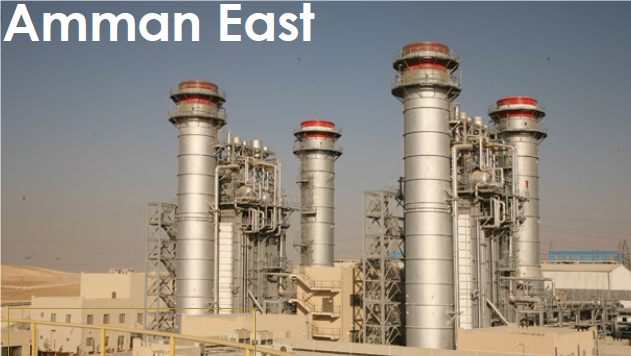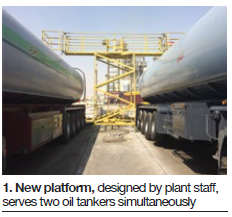Moving platform improves safety during unloading of oil
Challenge. Amman East, a 370-MW combined cycle powered by two dual-fuel Ansaldo Energia AE94 gas turbines and located near the Jordanian capital, relies heavily on oil today. The “political situation” in Egypt interrupted the plant’s gas supply in 2011.
About 30 to 36 tanker trucks are received daily at Amman East’s six-vehicle unloading bay. A necessary step in the unloading process is the need for a contractor to climb up on each truck to open its top hatch, thereby creating a fall hazard from a significant height. A full body harness with static lifeline was the original method of assuring personnel safety. However, the concrete bases anchoring the cumbersome static lifelines were damaged frequently by truck movement.
Solution. Initially, plant personnel thought to redesign the lifelines and modify their concrete bases consistent with the latest safety standards. But then they came up with the idea of a mobile platform to make the entire system more efficient, reliable, and safer.
A preliminary study supported this thinking.
Bids for a turnkey project solicited from several contractors were higher than the plant could afford, so design was brought in-house. The first of the three platforms required (one can serve two trucks simultaneously) was fabricated by a contractor and installed to test functionality and safety before ordering the other two (Fig 1). Success confirmed, the remaining two platforms were fabricated and installed.
Results. The platforms have met expectations, with the following benefits:
- Maintenance and operating costs have been reduced. Fall harnesses are no longer required, eliminating the costs associated with buying and caring for them, and for the repair of lifeline foundations.
- Unloading is faster because the hatches on two trucks can be accessed at one time.
- Safety is enhanced because the platform eliminates the need to use truck ladders, which can be slippery and difficult to climb.
- Plant involvement in platform design and installation allowed the project to be made operational for about one-third the cost contracting that work.
Project participants:
Mohammad Al-Qudah
Muin Goma
Optimizing water consumption pays big dividends
Jordan has one of the lowest levels of water resource availability, per capita, in the world. Water will become even more scarce over the next two decades given the nation’s population is expected to double. Plus, climate change potentially makes precipitation more uncertain and variable in this region. The bottom line: Management of water resources is a critical issue facing the national government. Owner AES is in lock-step with the country’s goal of reducing water consumption with its “Put safety and environment first” program.
Challenge. An AES team studied the plant’s water use and identified the following five areas with an opportunity for reducing consumption:
- Fire protection system. It relies on four pumps—two jockey pumps, one motor-driven pump, and one diesel-powered pump. An engineering review revealed two issues:
1. Leakage of underground piping.
2. Frequent starting/stopping of the jockey pumps used to maintain water pressure in sprinkler pipes, likely indicating leakage from that portion of the system. Investigators found that the pumps, which used to start every three hours or so, were now starting every 10 seconds.
- Blowdown cooling. Plant was designed to use raw water for quenching HRSG blowdown 24/7 before discharge to an onsite pond.
- Maintenance of service rooms in the administration building.
- Plant startup. The unavailability of gas forced the plant to stop/start operation from continuous.
- The former requires more water than the latter.
- A significant amount of water was being used to irrigate plants and gardens.
Solutions:
- Fire protection system. The water supply network was divided into zones and monitoring of pump operation was initiated. Plus, significant seat leakage was in evidence on one valve and that was corrected. Result: The jockey pumps are cycling on every three hours or so once again.
- Finally, NFPA standards were reviewed, and Amman East’s insurance provider was consulted, before modifying the fire system relief valves to discharge to the raw-water storage tank rather than to drains.
- Evaporation-pond water is now recycled for blowdown cooling instead of using raw water.
- Service rooms and restrooms were inspected and corrective actions taken to conserve water.
- Plant startup procedures were modified to minimize water use. One result of the optimization exercise was a reduction in steam venting (Fig 2). Another action: Increase the gas-turbine ramp rate, thereby reducing the time to reach merge-point steam pressure, saving water in the process (Fig 3).
- A treatment system was installed to allow use of evap-pond water for irrigation. Water quality, verified by a third-party testing firm, complies with Jordan’s agricultural water specifications.
Results, in gallons of water saved per day, were the following:
- Use of evap-pond water for cooling, 4000.
- Use of evap-pond water for irrigation, 8000.
- Eliminating leakage in the fire protection system, 9250.
- Modification of fire protection system relief valves, 1300.
- New startup procedure, 2650.
- Installing water-saving devices in the administration building, 400.
Total reduction in water consumption: 25,600 gal/day.
Annual financial benefit: $25,000.
Project participants: Anas Diab, performance manager
Khaled Oasem, plant chemist
Amman East Power Plant
AES Jordan PSC
370-MW, dual-fuel, 2 × 1 combined cycle located in Al Manakher, Jordan
Plant manager: Meftaur Rahman





